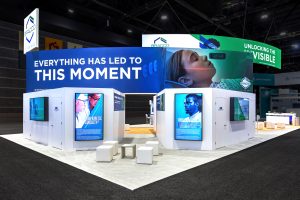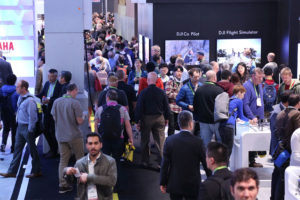The new year is bringing with it new challenges for the museum industry. As the pandemic has greatly impacted many institutions, those now looking toward recovery must adapt to new, changing environments or face further hardships. As a leading designer and fabricator in the museum industry, we’re taking a closer look at what we’re expecting to see in 2022 and beyond. We checked in with our team and industry partners to get their insights into what’s to come.
Their feedback addressed everything from the ever-changing digital revolution to a whole new way of doing business. We’re organizing these expectations into two categories: Maximizing Experiences and Boosting Bottom Lines.
In 2022, museums must continue to be ready to adjust their programs, exhibits, events and overall visitor experiences to the rapidly changing circumstances of an ongoing pandemic. A program planned to be in-person may have to move to virtual at the last minute due to unpredictable virus surges and other safety concerns. While this type of extreme adjustment has a ripple effect, today’s museums know how to manage the quick change efficiently and still deliver a quality program. Museums have become much more nimble in terms of how they meet the moment.
Zinnia Willits | Southeastern Museums Conference
2022 Museum Trends
Maximizing Experiences
The digital age is upon us and has been so for the last few decades. But never has it been so prevalent in the museum industry. Institutions are now re-inventing themselves to embrace new technologies. From virtual reality to world-class exhibits on the same device in which you could be reading this blog, the museum industry is in the midst of a digital awakening.
Immersive Experiences
Moving forward, museums are going to become larger than life. Visitors will find themselves fully engulfed in the exhibits.
Immersive art experiences rose to popularity in 2008 when Immersive Van Gogh launched in Europe. A similar experience launched in 2017 featuring the works of Claude Monet. Those groundbreaking exhibits are now traveling to North America and Asia, fascinating crowds worldwide.
With the constant development of ever-evolving, more affordable technologies, and the growing rise in virtual reality and state-of-the-art displays, you can expect these highly immersive experiences to become more commonplace in the industry.
As our society is increasingly connected, there is now a greater need than ever to offer highly engaging, customizable experiences for audiences. As new technologies emerge, expect museums to be quick to adapt to these new technologies.
Ellen Kaminski | Exhibit Concepts, Inc.
In November 2022, Egypt is set to open. The Grand Egyptian Museum which will serve as a crown jewel in the growing immersive museum movement. In Giza, Egypt, the museum will feature more than 100,000 artifacts spread across more than 5,000,000 sqft. In addition to its extensive collection, The Grand Egyptian Museum will also feature virtual reality experiences and a 3D cinema.
Accessible Exhibits
While permanent installations will likely always be preferred in the preservation of our histories, traveling exhibits and other alternatives will become a more popular trend in 2022. This comes as institutions look to expand their footprint and reach a wider audience.
With the pandemic shutting down the world and changing our lifestyles, museum attendance has dropped significantly in the past few years. According to an April 2021 study by our partners at the American Alliance of Museums, U.S. museums are seeing an average of 41% of pre-pandemic attendance.
With fewer people visiting museums, we expect museums to meet people where they are and take more of a unique approach to new programming. That means more exhibits popping up at local libraries, science centers, historical societies, community centers, shopping malls and even outdoor settings and venues.
The Smithsonian Institution has set the bar for traveling exhibits. They’ve been taking history across the U.S. since the 1950s and today have more than 100 exhibits currently touring the country. Local museums will also follow this trend, rolling out regional collections and highlighting more rarely seen artifacts.
Museums across the southeast are regularly collaborating with peer institutions on ways to affordably share collections and exhibitions so they can be seen by a wider audience. In the past, traveling exhibits were often cost-prohibitive for smaller organizations due to hefty insurance, loan, and shipping fees. Today, many museums will waive loan fees and come up with creative solutions to safely transport a collection to another museum. The more frequent exchange of objects and curatorial research has created dynamic partnerships and provided more access to collections across our region.
Zinnia Willits | Southeastern Museums Conference
Meanwhile, public art is also becoming more commonplace worldwide. The 2022 World Cup host city of Doha, Qatar is creating more than 40 outdoor art displays for the tournament.
Whether on the move or on public display, museums will embrace the future with fresh, new takes on engagement.
The pandemic forced many of us to reassess our values and priorities. Moving into 2022 and beyond, institutions will go back to the drawing board in order to make the best use of their spaces and engagement opportunities.
Ellen Kaminski | Exhibit Concepts, Inc.
Going Online
Beyond the fully immersive exhibits and traveling showcases, expect institutions to continue to take their missions online. For years, many have been embracing digital adaptations and you can expect that to continue. As we’ve mentioned, technology has come a long way and continues to evolve with more accessible options every day. Even the tiniest of museums with the smallest budgets can now reach greater relevancy thanks to the internet.
With the surge in social media, and audio and video production, museums can embrace more audiences by taking their messages online. In 2022, expect even more museums to launch virtual tour options. These online experiences not only cater to pandemic needs, but also allow visitors around the clock access to content and create more accessibility to underserved populations.
Digitizing Archives
In recent years, there has been a rapid embrace of new technologies in the museum industry. What started as simple audio and video has transitioned to the total modernization of exhibit spaces and collections.
Ellen Kaminski | Exhibit Concepts, Inc.
Taking a page from the early days of the pandemic, we’ll see more engaging, live and on-demand content on social channels. Museums will not simply be brick-and-mortar institutions, but influencers supplying education and outreach to all people.
Even beyond traditional messaging, artificial intelligence will also take the industry to the next level. Applications, such as StoryFile, allow pre-recorded content to become a two-way interactive experience.
Online access to museum collections is such a wonderful trend. Objects that may be too fragile for display can now be accessed, enjoyed, and studied by diverse communities across the globe. Three-dimensional scanning provides such detailed views of a piece of art or a historic artifact and you can get up close in a way you could not in person. Online collection access helps to protect and preserve museum objects while also making them truly accessible to the public.
Zinnia Willits | Southeastern Museums Conference
Boosting Bottom Lines
2022 isn’t just going to bring change to exhibits; it will also bring a shift to museum administrations and how institutions do business and raise funds. According to the American Alliance of Museums, more than 50% of American museums laid off and furloughed staff amid the pandemic. Similarly, museums’ bottom lines also took a big hit due to the pandemic. The average museum lost nearly $700,000 in revenue during the pandemic.
But how will museums overcome these hardships?
Back to Business
We believe 2022 will bring with it a renewed sense of normalcy, pandemic or not. As we mentioned, museums nationwide have seen a decrease in visitors over the past several years, but that could soon change. Field trips and group outings will once again grace the halls.
According to analysis published by IMPACTS Experience, museums can potentially expect near pre-pandemic attendance levels in 2022
In 2022, museums will move into the “next normal.” Going backward is not an option. Forward-thinking museums will consider the best aspects of their pre-pandemic operations and take those into this next phase.
Zinnia Willits | Southeastern Museums Conference
Bond Gallery
NFT Fad?
NFT’s (non-fungible tokens) have quickly become an overnight success. But as millennials flock to the blockchain movement, will the industry capitalize on the potential chance?
In 2021, Christie’s auctioned off their first-ever piece of NFT artwork. The piece, created by Beeple, sold for $69 million.
The auction’s success is just the tip of the iceberg for the NFT community. While the movement is still in its early stages, the museum community could play a role in the future of NFTs. However, the complexity of the topic and the volatility of the potential market makes it a risk.
Empowered Workforce
We’ve already mentioned that more than 50% of American museums laid off or furloughed employees due to the pandemic. While that number is sobering, there is some optimism; nearly half of respondents in the survey said they are planning on hiring in 2022. This hiring frenzy is sure to set the stage for a new generation of museum staff that will also prompt new, innovative ideas.
In addition to new faces, we’ll also see greater salary transparency in an attempt to keep more professionals in the industry. The growing, nationwide labor movements will yield salary resets and compensation reviews for employees who have been facing burnout from the pandemic.
If there can be a silver lining from the pandemic, expect museums to rebound on a path of growth.
Those entering the museum field in 2022 will find a landscape that is changing before their eyes in a positive way. Today, museums are embracing salary transparency, looking seriously at compensation comparisons and associated salary resets, and supporting flexible work environments that allow various types of remote work. Museum leaders are actively working to keep the great professionals they have and cultivate new ones through an additional focus on employee health and wellness and an active commitment to equitable hiring practices.
Zinnia Willits | Southeastern Museums Conference
Looking to the Future
In the words of U.S. President Abraham Lincoln, “The most reliable way to predict the future is to create it.” Whether creating immersive museum environments or taking on the latest technological advancements, 2022 is shaping up to be a big year for the museum community.
If you need help with your next project, don’t hesitate to reach out to us. We’re always here to help you with your next design, fabrication, or installation.









